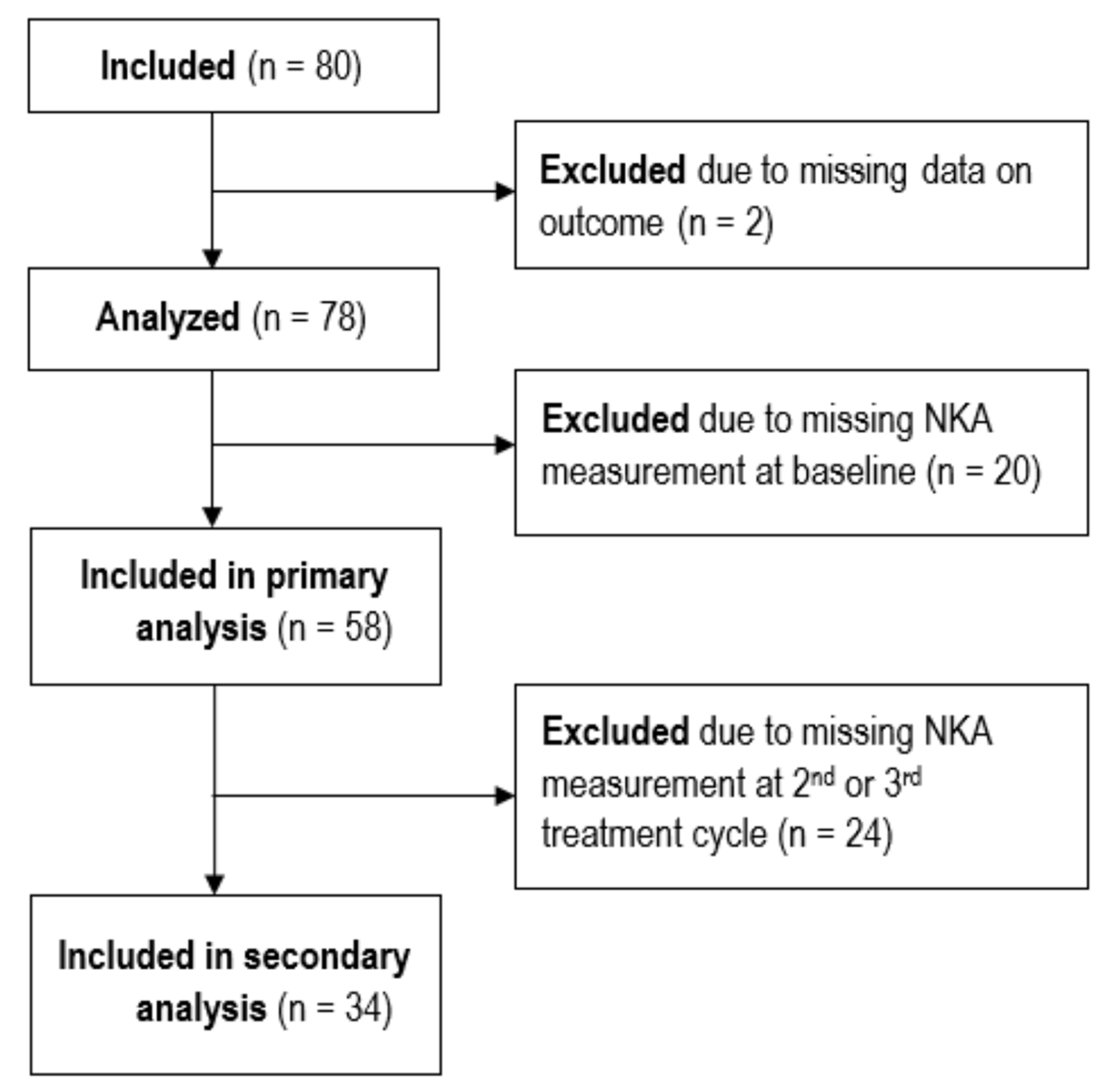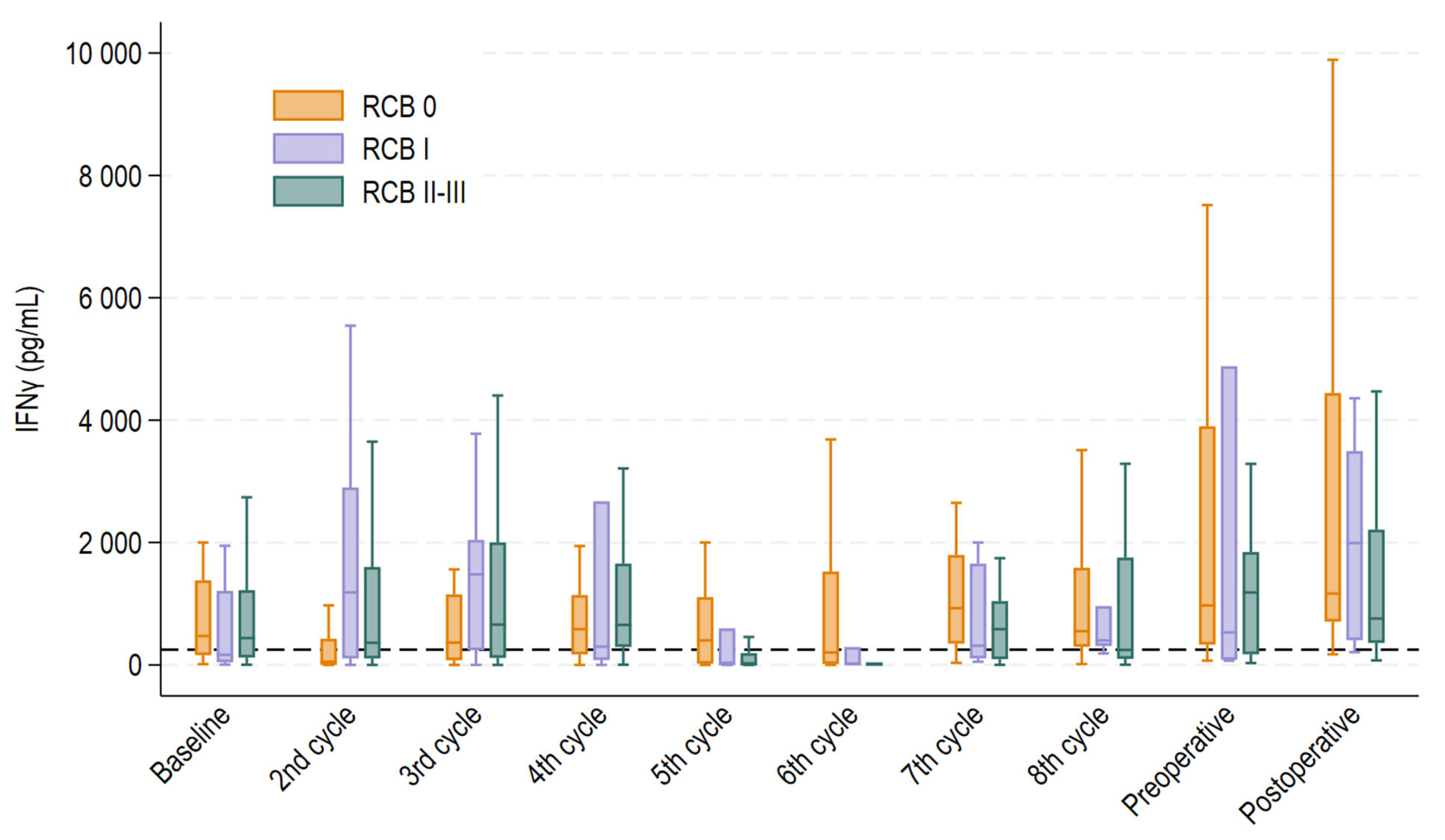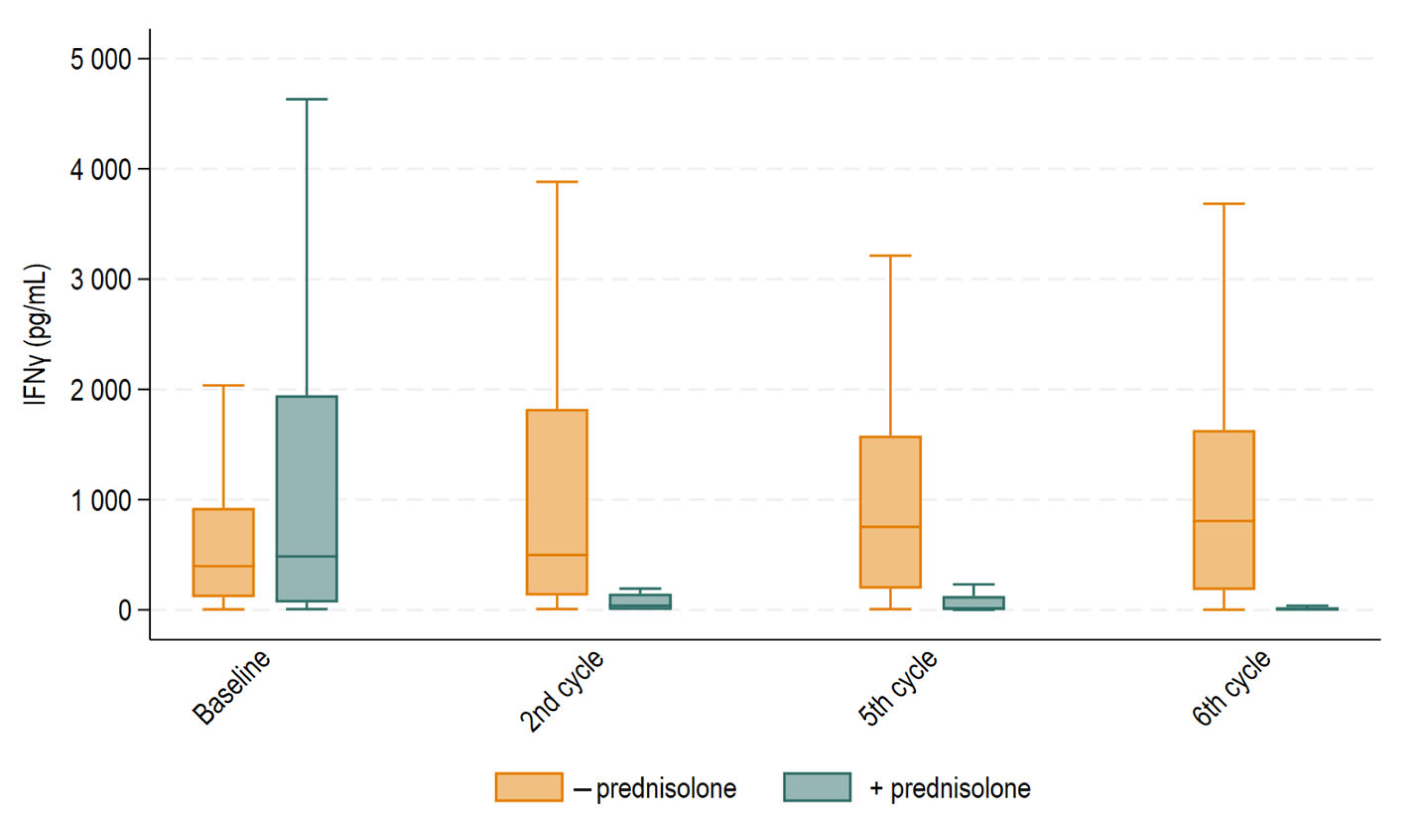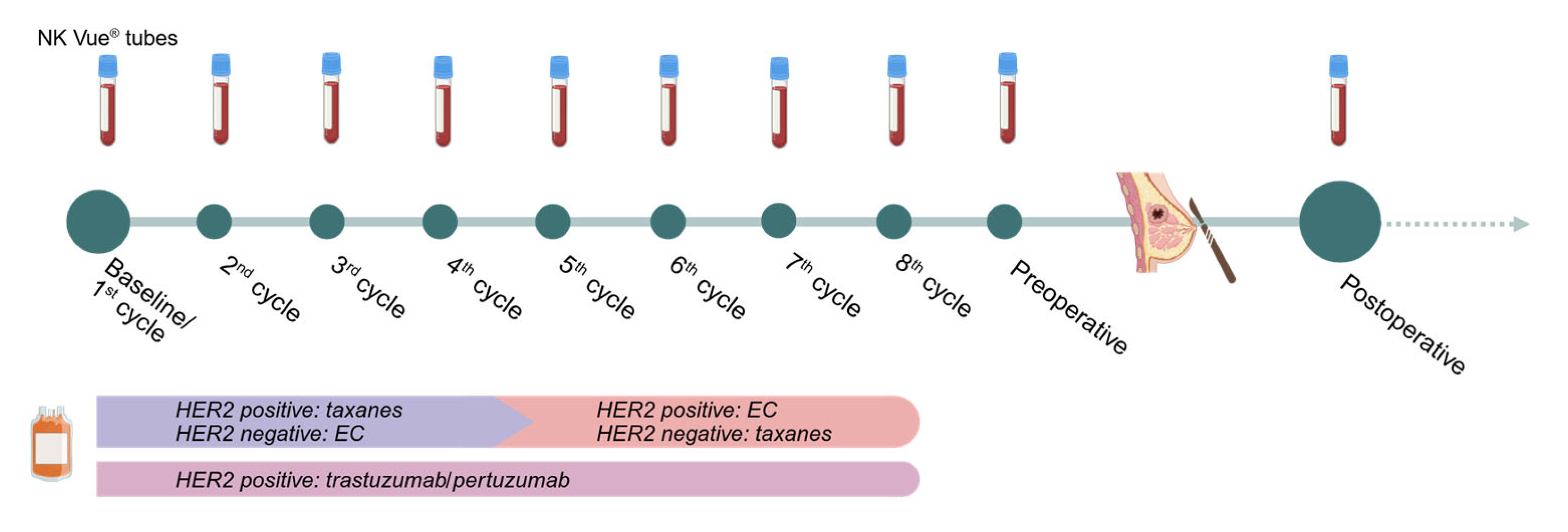Natural Killer Cell Activity and Response to Neoadjuvant Treatment in Breast Cancer Patients
Abstract
1. Introduction
2. Results
2.1. Patient Selection and Characteristics
2.2. Association Between NKA and Treatment Response
2.3. Association Between NKA and Survival Outcomes
2.4. Additional Findings Regarding the Association Between NKA and Treatment with Supportive Prednisolone
3. Discussion
4. Materials and Methods
4.1. Study Design and Study Population
4.2. Treatment and Follow-Up
4.3. Blood Samples, Laboratory Methods, and NKA Measurement
4.4. Statistics
Supplementary Materials
Author Contributions
Funding
Institutional Review Board Statement
Informed Consent Statement
Data Availability Statement
Acknowledgments
Conflicts of Interest
Abbreviations
| IDFS | Invasive disease free survival |
| IFNγ | Interferon-gamma |
| NKA | Natural killer cell activity |
| OS | Overall survival |
| PBL | Peripheral blood lymphocytes |
| RCB | Residual cancer burden |
| TILs | Tumor infiltrating lymphocytes |
| TNBC | Triple negative breast cancer |
References
- Bray, F.; Laversanne, M.; Sung, H.; Ferlay, J.; Siegel, R.L.; Soerjomataram, I.; Jemal, A. Global cancer statistics 2022: GLOBOCAN estimates of incidence and mortality worldwide for 36 cancers in 185 countries. CA Cancer J. Clin. 2024, 74, 229–263. [Google Scholar] [CrossRef] [PubMed]
- Early Breast Cancer Trialists’ Collaborative Group. Long-term outcomes for neoadjuvant versus adjuvant chemotherapy in early breast cancer: Meta-analysis of individual patient data from ten randomised trials. Lancet Oncol. 2018, 19, 27–39. [Google Scholar] [CrossRef] [PubMed]
- Gianni, L.; Pienkowski, T.; Im, Y.-H.; Tseng, L.-M.; Liu, M.-C.; Lluch, A.; Starosławska, E.; De La Haba-Rodríguez, J.R.; Im, S.-A.; Pedrini, J.L.; et al. 5-year analysis of neoadjuvant pertuzumab and trastuzumab in patients with locally advanced, inflammatory, or early-stage HER2-positive breast cancer (NeoSphere): A multicentre, open-label, phase 2 randomised trial. Lancet Oncol. 2016, 17, 791–800. [Google Scholar] [CrossRef] [PubMed]
- Schmid, P.; Cortes, J.; Dent, R.; Pusztai, L.; McArthur, H.; Kümmel, S.; Bergh, J.; Denkert, C.; Park, Y.H.; Hui, R.; et al. Event-free Survival with Pembrolizumab in Early Triple-Negative Breast Cancer. N. Engl. J. Med. 2022, 386, 556–567. [Google Scholar] [CrossRef]
- Cortazar, P.; Zhang, L.; Untch, M.; Mehta, K.; Costantino, J.P.; Wolmark, N.; Bonnefoi, H.; Cameron, D.; Gianni, L.; Valagussa, P.; et al. Pathological complete response and long-term clinical benefit in breast cancer: The CTNeoBC pooled analysis. Lancet 2014, 384, 164–172, Erratum in Lancet 2019, 393, 986. [Google Scholar] [CrossRef]
- Von Minckwitz, G.; Huang, C.-S.; Mano, M.S.; Loibl, S.; Mamounas, E.P.; Untch, M.; Wolmark, N.; Rastogi, P.; Schneeweiss, A.; Redondo, A.; et al. Trastuzumab Emtansine for Residual Invasive HER2-Positive Breast Cancer. N. Engl. J. Med. 2019, 380, 617–628. [Google Scholar] [CrossRef]
- Masuda, N.; Lee, S.-J.; Ohtani, S.; Im, Y.-H.; Lee, E.-S.; Yokota, I.; Kuroi, K.; Im, S.-A.; Park, B.-W.; Kim, S.-B.; et al. Adjuvant Capecitabine for Breast Cancer after Preoperative Chemotherapy. N. Engl. J. Med. 2017, 376, 2147–2159. [Google Scholar] [CrossRef]
- Bryceson, Y.T.; Chiang, S.C.; Darmanin, S.; Fauriat, C.; Schlums, H.; Theorell, J.; Wood, S.M. Molecular mechanisms of natural killer cell activation. J. Innate Immun. 2011, 3, 216–226. [Google Scholar] [CrossRef]
- Dianat-Moghadam, H.; Mahari, A.; Heidarifard, M.; Parnianfard, N.; Pourmousavi-Kh, L.; Rahbarghazi, R.; Amoozgar, Z. NK cells-directed therapies target circulating tumor cells and metastasis. Cancer Lett. 2021, 497, 41–53. [Google Scholar] [CrossRef]
- Paul, S.; Lal, G. The Molecular Mechanism of Natural Killer Cells Function and Its Importance in Cancer Immunotherapy. Front. Immunol. 2017, 8, 1124. [Google Scholar] [CrossRef]
- Imai, K.; Matsuyama, S.; Miyake, S.; Suga, K.; Nakachi, K. Natural cytotoxic activity of peripheral-blood lymphocytes and cancer incidence: An 11-year follow-up study of a general population. Lancet 2000, 356, 1795–1799. [Google Scholar] [CrossRef] [PubMed]
- Wen, S.W.C.; Nederby, L.; Andersen, R.F.; Nyhus, C.H.; Hilberg, O.; Jakobsen, A.; Hansen, T.F. NK cell activity and methylated HOXA9 ctDNA as prognostic biomarkers in patients with non-small cell lung cancer treated with PD-1/PD-L1 inhibitors. Br. J. Cancer 2023, 129, 135–142. [Google Scholar] [CrossRef] [PubMed]
- Villegas, F.R.; Coca, S.; Villarrubia, V.G.; Jiménez, R.; Chillón, M.J.; Jareño, J.; Zuil, M.; Callol, L. Prognostic significance of tumor infiltrating natural killer cells subset CD57 in patients with squamous cell lung cancer. Lung Cancer 2002, 35, 23–28. [Google Scholar] [CrossRef] [PubMed]
- Coca, S.; Perez-Piqueras, J.; Martinez, D.; Colmenarejo, A.; Saez, M.A.; Vallejo, C.; Martos, J.A.; Moreno, M. The prognostic significance of intratumoral natural killer cells in patients with colorectal carcinoma. Cancer 1997, 79, 2320–2328. [Google Scholar] [CrossRef]
- Ishigami, S.; Natsugoe, S.; Tokuda, K.; Nakajo, A.; Xiangming, C.; Iwashige, H.; Aridome, K.; Hokita, S.; Aikou, T. Clinical impact of intratumoral natural killer cell and dendritic cell infiltration in gastric cancer. Cancer Lett. 2000, 159, 103–108. [Google Scholar] [CrossRef]
- Dewan, Z.; Takada, M.; Terunuma, H.; Deng, X.; Ahmed, S.; Yamamoto, N.; Toi, M. Natural killer activity of peripheral-blood mononuclear cells in breast cancer patients. Biomed. Pharmacother. 2009, 63, 703–706. [Google Scholar] [CrossRef]
- Liu, Z.; Ding, M.; Qiu, P.; Pan, K.; Guo, Q. Natural killer cell-related prognostic risk model predicts prognosis and treatment outcomes in triple-negative breast cancer. Front. Immunol. 2023, 14, 1200282. [Google Scholar] [CrossRef]
- Zhang, J.; Zhang, M.; Tian, Q.; Yang, J. A novel model associated with tumor microenvironment on predicting prognosis and immunotherapy in triple negative breast cancer. Clin. Exp. Med. 2023, 23, 3867–3881. [Google Scholar] [CrossRef]
- Nederby, L.; Jakobsen, A.; Hokland, M.; Hansen, T.F. Quantification of NK cell activity using whole blood: Methodological aspects of a new test. J. Immunol. Methods 2018, 458, 21–25. [Google Scholar] [CrossRef]
- Lee, S.-B.; Cha, J.; Kim, I.-K.; Yoon, J.C.; Lee, H.J.; Park, S.W.; Cho, S.; Youn, D.-Y.; Lee, H.; Lee, C.H.; et al. A high-throughput assay of NK cell activity in whole blood and its clinical application. Biochem. Biophys. Res. Commun. 2014, 445, 584–590. [Google Scholar] [CrossRef]
- Hansen, T.F.; Nederby, L.; Zedan, A.H.; Mejlholm, I.; Henriksen, J.R.; Steffensen, K.D.; Thomsen, C.B.; Raunkilde, L.; Jensen, L.H.; Jakobsen, A. Correlation Between Natural Killer Cell Activity and Treatment Effect in Patients with Disseminated Cancer. Transl. Oncol. 2019, 12, 968–972. [Google Scholar] [CrossRef]
- Cho, Y.-H.; Choi, M.G.; Kim, D.H.; Choi, Y.J.; Kim, S.Y.; Sung, K.J.; Lee, J.C.; Kim, S.-Y.; Rho, J.K.; Choi, C.-M. Natural Killer Cells as a Potential Biomarker for Predicting Immunotherapy Efficacy in Patients with Non-Small Cell Lung Cancer. Target Oncol. 2020, 15, 241–247. [Google Scholar] [CrossRef]
- Krukowski, K.; Eddy, J.; Kosik, K.L.; Konley, T.; Janusek, L.W.; Mathews, H.L. Glucocorticoid dysregulation of natural killer cell function through epigenetic modification. Brain Behav. Immun. 2011, 25, 239–249. [Google Scholar] [CrossRef] [PubMed]
- Chen, L.; Jondal, M.; Yakimchuk, K. Regulatory effects of dexamethasone on NK and T cell immunity. Inflammopharmacology 2018, 26, 1331–1338. [Google Scholar] [CrossRef] [PubMed]
- Morgan, D.J.; Davis, D.M. Distinct Effects of Dexamethasone on Human Natural Killer Cell Responses Dependent on Cytokines. Front. Immunol. 2017, 8, 432. [Google Scholar] [CrossRef] [PubMed]
- Nair, M.P.N.; Schwartz, S.A. Immunomodulatory effects of corticosteroids on natural killer and antibody-dependent cellular cytotoxic activities of human lymphocytes. J. Immunol. 1984, 132, 2876–2882. [Google Scholar] [CrossRef]
- Thum, M.; Bhaskaran, S.; Abdalla, H.I.; Ford, B.; Sumar, N.; Bansal, A. Prednisolone suppresses NK cell cytotoxicity in vitro in women with a history of infertility and elevated NK cell cytotoxicity. Am. J. Reprod. Immunol. 2008, 59, 259–265. [Google Scholar] [CrossRef]
- Holbrook, N.J.; Cox, W.I.; Horner, H.C. Direct suppression of natural killer activity in human peripheral blood leukocyte cultures by glucocorticoids and its modulation by interferon. Cancer Res. 1983, 43, 4019–4025. [Google Scholar]
- Denkert, C.; Von Minckwitz, G.; Darb-Esfahani, S.; Lederer, B.; Heppner, B.I.; Weber, K.E.; Budczies, J.; Huober, J.; Klauschen, F.; Furlanetto, J.; et al. Tumour-infiltrating lymphocytes and prognosis in different subtypes of breast cancer: A pooled analysis of 3771 patients treated with neoadjuvant therapy. Lancet Oncol. 2018, 19, 40–50. [Google Scholar] [CrossRef]
- He, L.; Wang, Y.; Wu, Q.; Song, Y.; Ma, X.; Zhang, B.; Wang, H.; Huang, Y. Association between levels of tumor-infiltrating lymphocytes in different subtypes of primary breast tumors and prognostic outcomes: A meta-analysis. BMC Womens Health 2020, 20, 194. [Google Scholar] [CrossRef]
- Vicente Conesa, M.A.; Garcia-Martinez, E.; Gonzalez Billalabeitia, E.; Chaves Benito, A.; Garcia Garcia, T.; Vicente Garcia, V.; Ayala de la Peña, F. Predictive value of peripheral blood lymphocyte count in breast cancer patients treated with primary chemotherapy. Breast 2012, 21, 468–474. [Google Scholar] [CrossRef]
- Feng, J.; Yi, J.; Zouxu, X.; Li, J.; Xiong, Z.; Huang, X.; Zhong, W.; Huang, W.; Ye, F.; Wang, X. Peripheral blood lymphocytes subtypes as new predictors for neoadjuvant therapy efficacy in breast cancer. Cancer Med. 2022, 11, 2923–2933. [Google Scholar] [CrossRef]
- Kjær, I.M.; Kahns, S.; Timm, S.; Andersen, R.F.; Madsen, J.S.; Jakobsen, E.H.; Tabor, T.P.; Jakobsen, A.; Bechmann, T. Phase II trial of delta-tocotrienol in neoadjuvant breast cancer with evaluation of treatment response using ctDNA. Sci. Rep. 2023, 13, 8419. [Google Scholar] [CrossRef] [PubMed]
- Verma, C.; Kaewkangsadan, V.; Eremin, J.M.; Cowley, G.P.; Ilyas, M.; El-Sheemy, M.A.; Eremin, O. Natural killer (NK) cell profiles in blood and tumour in women with large and locally advanced breast cancer (LLABC) and their contribution to a pathological complete response (PCR) in the tumour following neoadjuvant chemotherapy (NAC): Differential restoration of blood profiles by NAC and surgery. J. Transl. Med. 2015, 13, 180. [Google Scholar] [CrossRef]
- Kim, R.; Kawai, A.; Wakisaka, M.; Shimoyama, M.; Yasuda, N.; Ito, M.; Kin, T.; Arihiro, K. Accumulation of CD56+ CD16− Natural Killer Cells in Response to Preoperative Chemotherapy for Breast Cancer. World J. Oncol. 2024, 15, 682–694. [Google Scholar] [CrossRef] [PubMed]
- Portale, F.; Di Mitri, D. NK Cells in Cancer: Mechanisms of Dysfunction and Therapeutic Potential. Int. J. Mol. Sci. 2023, 24, 9521. [Google Scholar] [CrossRef] [PubMed]
- Jin, H.; Choi, H.; Kim, E.; Lee, H.H.; Cho, H.; Moon, A. Natural killer cells inhibit breast cancer cell invasion through downregulation of urokinase-type plasminogen activator. Oncol. Rep. 2021, 45, 299–308. [Google Scholar] [CrossRef]
- Quock, J.; Dea, G.; Tanaka, M.; Gandara, D.; Lara, P.; Lau, D. Premedication strategy for weekly paclitaxel. Cancer Investig. 2002, 20, 666–672. [Google Scholar] [CrossRef]
- Constantinou, C.; Charalambous, C.; Kanakis, D. Vitamin E and cancer: An update on the emerging role of gamma and delta tocotrienols. Eur. J. Nutr. 2020, 59, 845–857. [Google Scholar] [CrossRef]
- Symmans, W.F.; Peintinger, F.; Hatzis, C.; Rajan, R.; Kuerer, H.; Valero, V.; Assad, L.; Poniecka, A.; Hennessy, B.; Green, M.; et al. Measurement of residual breast cancer burden to predict survival after neoadjuvant chemotherapy. J. Clin. Oncol. 2007, 25, 4414–4422. [Google Scholar] [CrossRef]





| Normal NKA at Baseline (n = 37) | Low NKA at Baseline (n = 21) | Missing Baseline NKA Measurement (n = 20) | All (n = 78) | |
|---|---|---|---|---|
| Age | 55.7 (28.5–82.8) | 56.0 (33.9–79.8) | 52.4 (36.4–77.0) | 55.0 (28.5–82.8) |
| Menopausal status | ||||
| Pre | 17 (46%) | 10 (48%) | 11 (55%) | 38 (49%) |
| Post | 20 (54%) | 11 (52%) | 9 (45%) | 40 (51%) |
| Performance status | ||||
| 0 | 36 (97%) | 18 (86%) | 20 (100%) | 74 (95%) |
| 1 | - | 2 (9%) | - | 2 (3%) |
| Missing | 1 (3%) | 1 (5%) | - | 2 (2%) |
| ER status (pre-treatment biopsy) a | ||||
| Positive (≥1%) | 25 (68%) | 13 (62%) | 14 (70%) | 52 (67%) |
| Negative (0%) | 12 (32%) | 8 (38%) | 6 (30%) | 26 (33%) |
| HER2 status (pre-treatment biopsy) b | ||||
| Positive | 14 (38%) | 9 (43%) | 7 (35%) | 30 (38%) |
| Negative | 23 (62%) | 12 (57%) | 13 (65%) | 48 (62%) |
| Histological type (combined biopsy and surgical specimen) | ||||
| Ductal | 24 (65%) | 12 (57%) | 13 (65%) | 49 (63%) |
| Lobular | 3 (8%) | - | - | 3 (4%) |
| Other/unknown | 10 (27%) | 9 (43%) | 7 (35%) | 26 (33%) |
| Tumor size (baseline MRI) | ||||
| T1 < 20 mm | 6 (16%) | 2 (10%) | 1 (5%) | 9 (12%) |
| T2 > 21 mm < 50 mm | 17 (46%) | 15 (71%) | 12 (60%) | 44 (56%) |
| T3 > 50 mm | 11 (30%) | 2 (10%) | 7 (35%) | 20 (26%) |
| MRI not performed | 3 (8%) | 2 (9%) | - | 5 (6%) |
| Pathological lymph nodes c | ||||
| Yes | 23 (62%) | 14 (67%) | 15 (75%) | 52 (67%) |
| No | 14 (38%) | 7 (33%) | 5 (25%) | 26 (33%) |
| Malignancy grade (pre-treatment biopsy) | ||||
| 1 | - | 1 (5%) | - | 1 (1%) |
| 2 | 16 (43%) | 6 (29%) | 8 (40%) | 30 (39%) |
| 3 | 8 (22%) | 6 (29%) | 5 (25%) | 19 (25%) |
| Unknown | 13 (35%) | 8 (37%) | 7 (35%) | 28 (35%) |
| Treatment with tocotrienol d | ||||
| Yes | 9 (24%) | 13 (62%) | 14 (70%) | 36 (46%) |
| No | 28 (73%) | 8 (38%) | 6 (30%) | 42 (53%) |
| Baseline NK Cell Activity | RCB Class | |||
|---|---|---|---|---|
| 0 | I | II + III | Total | |
| < 250 pg/mL | 9 (33%) | 3 (50%) | 9 (36%) | 21 |
| ≥ 250 pg/mL | 18 (67%) | 3 (50%) | 16 (64%) | 37 |
| Total | 27 | 6 | 25 | 58 |
| Dynamics in NK Cell Activity from Baseline to 3rd Treatment Cycle | RCB Class | |||
|---|---|---|---|---|
| 0 | I | II + III | Total | |
| ≥ 250 pg/mL) | 3 | 2 | 5 | 10 |
| < 250 pg/mL) | 4 | 1 | 1 | 6 |
| levels) | 9 | 2 | 7 | 18 |
| Total | 16 | 5 | 13 | 34 |
Disclaimer/Publisher’s Note: The statements, opinions and data contained in all publications are solely those of the individual author(s) and contributor(s) and not of MDPI and/or the editor(s). MDPI and/or the editor(s) disclaim responsibility for any injury to people or property resulting from any ideas, methods, instructions or products referred to in the content. |
© 2025 by the authors. Licensee MDPI, Basel, Switzerland. This article is an open access article distributed under the terms and conditions of the Creative Commons Attribution (CC BY) license (https://creativecommons.org/licenses/by/4.0/).
Share and Cite
Gamborg-Kvist, S.H.; Maae, E.; Timm, S.; Kjær, I.M.; Bechmann, T.; Hansen, T.F.; Nederby, L. Natural Killer Cell Activity and Response to Neoadjuvant Treatment in Breast Cancer Patients. Int. J. Mol. Sci. 2025, 26, 10357. https://doi.org/10.3390/ijms262110357
Gamborg-Kvist SH, Maae E, Timm S, Kjær IM, Bechmann T, Hansen TF, Nederby L. Natural Killer Cell Activity and Response to Neoadjuvant Treatment in Breast Cancer Patients. International Journal of Molecular Sciences. 2025; 26(21):10357. https://doi.org/10.3390/ijms262110357
Chicago/Turabian StyleGamborg-Kvist, Sofie Høier, Else Maae, Signe Timm, Ina Mathilde Kjær, Troels Bechmann, Torben Frøstrup Hansen, and Line Nederby. 2025. "Natural Killer Cell Activity and Response to Neoadjuvant Treatment in Breast Cancer Patients" International Journal of Molecular Sciences 26, no. 21: 10357. https://doi.org/10.3390/ijms262110357
APA StyleGamborg-Kvist, S. H., Maae, E., Timm, S., Kjær, I. M., Bechmann, T., Hansen, T. F., & Nederby, L. (2025). Natural Killer Cell Activity and Response to Neoadjuvant Treatment in Breast Cancer Patients. International Journal of Molecular Sciences, 26(21), 10357. https://doi.org/10.3390/ijms262110357







